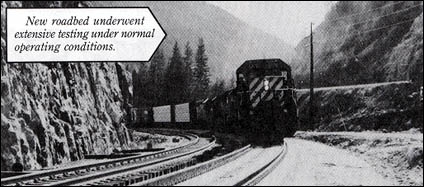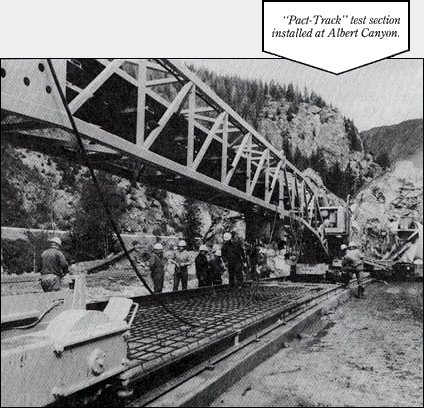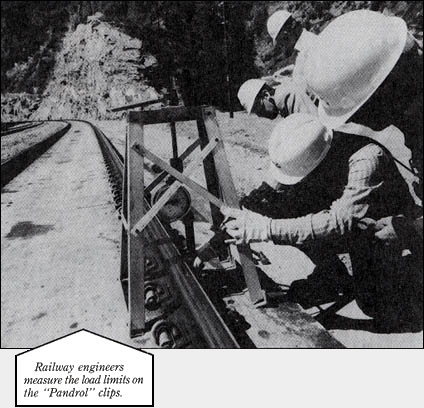Vol. 18 No. 2
February, 1988
|
Make Tomorrow Happen
|
"Pact-Track" Contract Let
By Steve Morris

Calgary - A contract for the installation of North America's first
"Pact-Track" railbed system has been awarded by CP Rail to a joint-venture
company involving Manning Construction, of Aldergrove B.C., and mcGregor Paving Company Limited, of Chesterfield,
England.
The contract includes installation of 16.57 kilometres of the concrete roadbed in the two tunnels of the Rogers Pass
Double Tracking and Grade Reduction Project.

BREAKTHROUGH
The "Pact-Track" roadbed system was developed by British Rail and uses a reinforced,
cast-in-place concrete foundation, measuring 22.9 centimetres thick; special clips hold the rails in
place.
The roadbed eliminates the use of crushed rock or slag as ballast and wood or concrete railway ties.
"The use of this new system is a breakthrough on the North American railroad scene", said John Fox,
vice-president, special projects.
"Although the system has been used successfully in England it had to be adapted to the heavier and more
demanding stresses of the North American railway system".
Before committing to "Pact-Track", CP Rail installed a 283.5 metre long test section at
Albert Canyon, about 24 kilometres west of the project, in late 1984.
"To ensure the system wouldn't fail under the heavier axle loads, we conducted two years of tests under extreme
rail load and weather conditions", he said.
These tests included measuring concrete integrity as well as the effects of vibrations and deposits of oil and grease
from passing trains on the "Pact-Track" base.
Installation of the system will begin in May and will continue until September, 1988. A special machine will be
imported from England to lay the more than 9,200 cubic metres of concrete the installation requires.
The machine will lay the "Pact-Track" in the Mount Shaughnessy and Mount Macdonald tunnels at
an estimated rate of about 1,000 metres a week.
To install the roadbed, the machine will move on rails secured to the sub-invert, concrete floor of the
tunnels on which the "Pact-Track" will be laid. Installation of the sub-invert
floor, which contains the drainage system for the tunnels, was completed recently.

INSTALLATION
Concrete is fed into the front end of the machine and travels along a 10.66 metre long conveyor belt towards the
rear of the equipment.
While concrete is being poured into a form attached to the end of the machine, crews working underneath the conveyor
install reinforcing mesh onto which the concrete is poured.
After the 2.43 metre wide concrete slab has cured, a 10 millimetre thick rubber compound pad is placed where the rail
will be attached. The rail is installed using "Pandrol" clips. More than 29 kilometres of padding and
116,300 rail clips are required to complete the work.
BETTERS SAFETY
"The pad is a very important part of the system as it absorbs the load of the wheels pushing on the rails",
Mr. Fox said. "Without it, the forces would break up the "Pact-Track" slab".
"Pact-Track", designed primarily for use in tunnel systems, increases safety, reduces
ongoing maintenance costs, and greatly improves rolling stock ride, he said.
Furthermore, it allows for permanent rail alignment which is not possible with conventional railbed
systems.
This CP Rail News article is copyright
1988 by the Canadian Pacific Railway and is reprinted here with
their permission. All photographs, logos, and trademarks are the property of the Canadian Pacific Railway
Company.
|